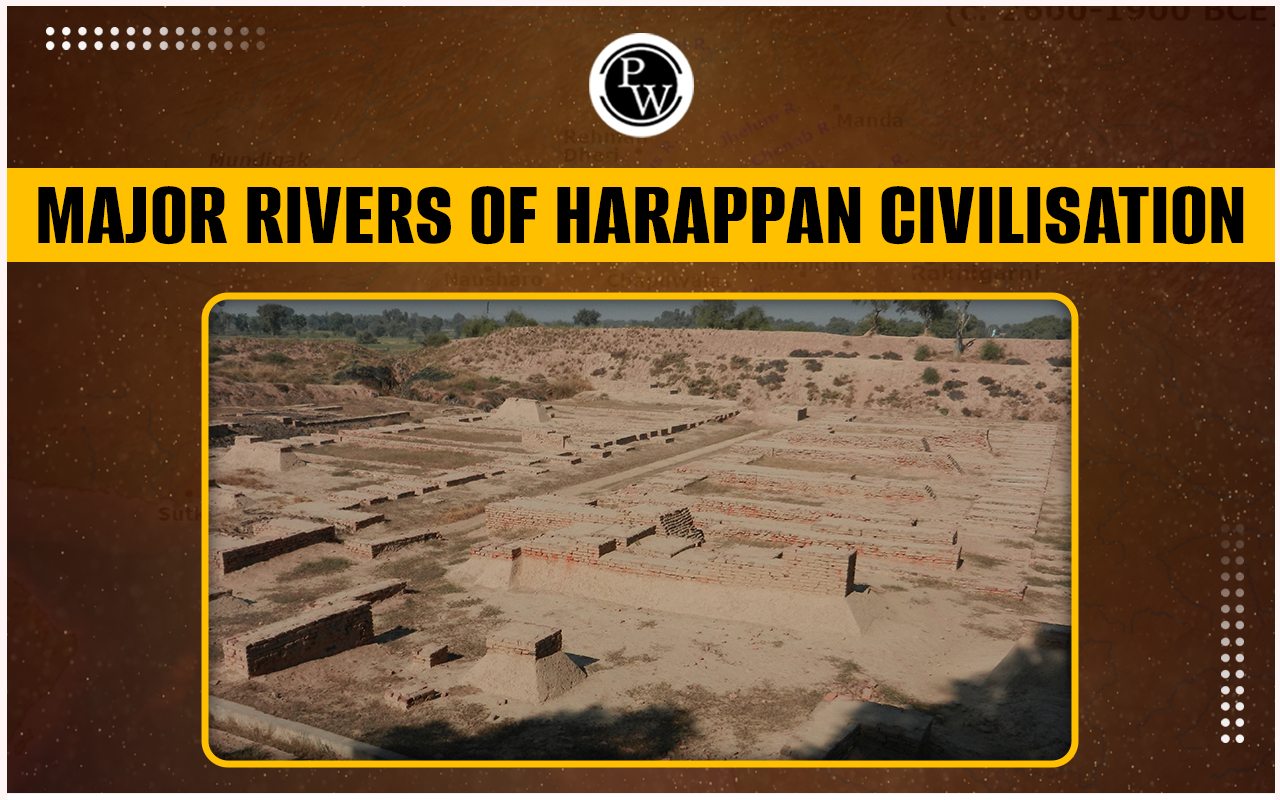

Major Rivers of Harappan Civilization: Harappan civilization is among the oldest civilizations in Indian history. The Harappan Civilization played an important role in the human lives of that time as it was the earliest known Urban civilization in the Indian subcontinent. It is a part of the Indus River Valley Civilization, which was considered the Bronze Age civilization. The Harappan civilization flourished along the Indus River between 2600 and 1900 BCE. The discoveries made here gave us great insight into the lifestyle back then lived by our ancestors.
Major Rivers in the Harappan Civilization
The Harappan civilization flourished alongside the Indus River for 2 millennia, leaving a legacy that marked the start of Indian history. The geographical limit of Harappan civilization was spread across modern-day northeastern Afghanistan to northwest India. Several cities dotted the Indus River and its tributaries, enabling cultural trade and exchange. These are still studied and contribute with valuable inputs about social and economic development during that ancient period of life.Significance of Rivers
Rivers have been considered essential since that period for civilization to thrive and flourish for several reasons.- The frequent flooding of rivers contributed to the formation of fertile plains which could be used for irrigation providing a reliable source of food, this, in turn, supported larger populations and aided permanent settlements.
- The rivers also acted as natural highways which helped move around goods, hence enabling trade and cultural exchange.
- Rivers also provided a constant source of freshwater hence providing clean drinking water and helping to establish and sustain settlements. This allowed the civilizations to flourish.
- The Rivers also helped acquire resources like minerals and clay for building settlements. In Harappan civilization, there was also the role of social and religious significance of rivers for these are life-giving waterways.
Indus River in the Harappan Civilization
Historical Significance
It is believed to be the lifeblood of the Harappan Civilization. The Indus River is where the oldest form of civilization is believed to have existed, between Sindh and Punjab, and where the biggest and greatest civilization emerged in ancient times. The Indus River is believed to have played a big role in the development of harappan civilization as it helped in the accumulation of rich soil which enabled smooth cultivation which contributed to the rich source of food and aided trade and exchange for the civilization to flourish.Geography
- The name of ‘India’ comes from the ‘Indus’. It comes from a glacier called Bokhar Chu in the Tibetan Area of Mount Kailash.
- It originates in Demchok and runs northwest before joining Ladakh in India and flows between the Karakoram ranges.
- The collected water from 5 tributaries- Jhelum, Chenab, Ravi, Beas, and Satluj- arrive at the Indus from Panchnad.
Economic and Cultural Impact
- The river provided for the deposition of fertile Soil on the banks of the Harappan civilization in large amounts which helped in getting fertile land for the cultivation of crops and hence became the reason for good food sources.
- Indus River enabled inland water Transportation which helped with trading goods around especially internationally due to the vast spread of Harappan civilization and also led to cultural exchanges introducing various cultures in the civilization.
- The Indus River was also a source of fresh water for sustaining the settlements and providing establishment over vast areas of land. It also helped get minerals and resources that the Indus River carried along with it.
Ghaggar-Hakra River System in Harappan Civilization
Identifying the Ghaggar-Hakra River
The Ghaggar-Hakra river system is a seasonal river that flows through northwestern India and Pakistan. It is a rain-fed river and flows only during the monsoon season. The Saraswati River is believed to be an ancient perennial of the seasonal Ghaggar River that flowed through the heart of the Harappan civilization in the Bronze Age through Northwestern India. Despite the abundance of settlements along the channel of river Ghaggar, it is believed that Harappans depended on monsoon rains. The river is believed to have contributed greatly to the development of early Harappan settlements along its banks.Geography
- The Ghaggar river originates from the Siwalik Hills of Himachal Pradesh, and flows through Punjab, Haryana, and then into Rajasthan where it eventually dries up.
- The river is known as Ghaggar before the Ottu barrage and as the Hakra downstream of the barrage.
- Its tributaries are Kaushaya, Markanda, sarsuti, Tangri and Chautang.
Role in Harappan Civilization
- It is often described as the Vedic Saraswati River.
- Along the banks of the Ghaggar River, many settlements of the Harappan Civilization were excavated which shows its significance.
- It is also believed that rivers Sutlej and Yamuna flowed into the Ghaggar-Hakra River bed once.
Other Rivers in Harappan Civilization
There were believed to be other rivers like Yamuna, Saraswati, and Ganga to be a part of the rivers that influenced the Harappan Civilization and are still flowing in the present day, being excavated in present times as well to find evidence of the Harappan Civilization. They still flow through the northeastern part of India. Yamuna n ganga could have been a part of the Indus River and Saraswati River was a part of the Ghaggar- Hakra River in ancient times which was a major contributor to the Harappan Civilization.Multifaceted Role of Rivers in Harappan Civilization
Even though there is no guarantee of this, the archeological evidence shows how it was more than just a food or transportation source:- Big pools discovered in Harappan cities might have been for special baths to connect with the holy river or wash away bad vibes.
- Harappan cities were neatly organized, and some folks think they were built around the directions of the Indus River. The river might have been a sacred guide for where to put everything.
- Fish and water symbols on Harappan settlements could be pictures of important water spirits who looked after the people and kept the rivers flowing.
Major Rivers Of Harappan Civilization FAQs
What 2 main rivers were crucial to the Indus civilization?
The Indus River and The Ghaggar-Hakra River are 2 main rivers crucial to the Indus civilization.
What are the two main Harappan Civilizations?
Harappa and Mohenjo-Daro are the two main Harappan Civilizations.
What river is the Harappan civilization named after?
The Harappan Civilization is also known as the ‘Indus River Valley Civilization’, hence the name comes from the river Indus.
Who founded Harappa?
Harappa was founded in 1921 by a person called D.Sahni and hence the Harappan Civilization came into discovery.
Where was the Harappan civilization located?
The Harappan Civilization was located along the basins of the Indus River and Ghaggar-Hakra River.
🔥 Trending Blogs
Talk to a counsellorHave doubts? Our support team will be happy to assist you!

Check out these Related Articles
Free Learning Resources
PW Books
Notes (Class 10-12)
PW Study Materials
Notes (Class 6-9)
Ncert Solutions
Govt Exams
Class 6th to 12th Online Courses
Govt Job Exams Courses
UPSC Coaching
Defence Exam Coaching
Gate Exam Coaching
Other Exams
Know about Physics Wallah
Physics Wallah is an Indian edtech platform that provides accessible & comprehensive learning experiences to students from Class 6th to postgraduate level. We also provide extensive NCERT solutions, sample paper, NEET, JEE Mains, BITSAT previous year papers & more such resources to students. Physics Wallah also caters to over 3.5 million registered students and over 78 lakh+ Youtube subscribers with 4.8 rating on its app.
We Stand Out because
We provide students with intensive courses with India’s qualified & experienced faculties & mentors. PW strives to make the learning experience comprehensive and accessible for students of all sections of society. We believe in empowering every single student who couldn't dream of a good career in engineering and medical field earlier.
Our Key Focus Areas
Physics Wallah's main focus is to make the learning experience as economical as possible for all students. With our affordable courses like Lakshya, Udaan and Arjuna and many others, we have been able to provide a platform for lakhs of aspirants. From providing Chemistry, Maths, Physics formula to giving e-books of eminent authors like RD Sharma, RS Aggarwal and Lakhmir Singh, PW focuses on every single student's need for preparation.
What Makes Us Different
Physics Wallah strives to develop a comprehensive pedagogical structure for students, where they get a state-of-the-art learning experience with study material and resources. Apart from catering students preparing for JEE Mains and NEET, PW also provides study material for each state board like Uttar Pradesh, Bihar, and others
Copyright © 2025 Physicswallah Limited All rights reserved.
Get App











